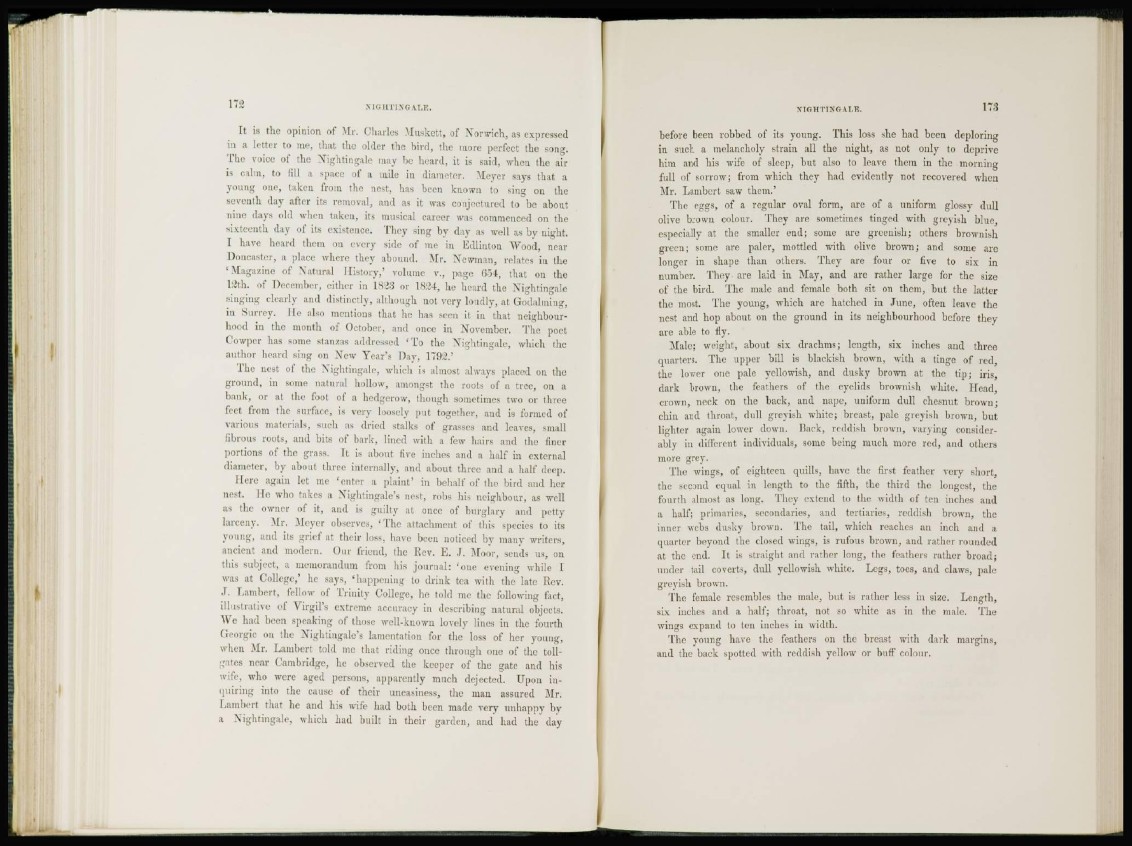
I t is the opinion of Mr. Charles Muskett, of Norwich, as expressed
in a letter to me, that the older the bird, the more perfect the song.
The voice of the Nightingale may be heard, it is said, when the air
is calm, to fill a space of a mile in diameter. Meyer says that a
young one, taken from the nest, has been known to sing on the
seventh day after its removal, and as it was conjectured to be about
nine days old when taken, its musical career was commenced on the
sixteenth day of ils existence. They sing by day as well as b y night.
I have heard them on every side of me in Edliuton Wood, near
Doncaster, a place where they abound. Mr. Newman, relates in the
' Magazine of Natural History,' volume v., page 654, that on the
l£th. of December, either in 1828 or 1884, he heard the Nightingale
singing (dearly and distinctly, although not very loudly, at Gmlalming,
in Surrey, lie also mentions that he has seen it in that neighbourhood
in (he month of October, and once in November. The poet
Cowpcr has some stanzas addressed ' T o the Nightingale, which the
author heard sing on New Year's Day, 1792.'
The nest of the Nightingale, which is almost always placed on the
ground, in some natural hollow, amongst the roots of a tree, on a
bank, or at the foot of a hedgerow, though sometimes two or three
feet from the surface, is very loosely put together, and is formed of
various materials, such as dried stalks of grasses and leaves, small
fibrous roots, and bits of bark, lined with a few hairs and the finer
portions of the grass. It is about rive inches and a half in external
diameter, by about three internally, and about three and a half deep.
Here again let me 'enter a plaint' in behalf of the bird and her
nest, lie who takes a Nightingale's nest, robs hU neighbour, as well
as the owner of it, and is guilty at once of burglary and petty
larceny. Mr. Meyer observes, ' T h e attachment of this species to its
young, and its grief at their loss, have been noticed by many writers,
ancient and modern. Our friend, the Rev. E. J. Moor, sends us, on
this subject, a memorandum from his journal: 'one evening while I
was at College,* he says, 'happening to drink tea with the late Rev.
J. Lambert, fellow of Trinity College, he told me the following fact,
illustrative of Virgil's extreme accuracy in describing natural objects.
We had been speaking (if' those well-known lovely lines in the fourth
Géorgie on the Nightingale's lamentation for the loss of her young,
when Mr. Lambert told me that riding once through one of the tollg
i • es near Cambridge, he observed the keeper of the gate and his
wife, who were aged persons, apparently much dejected. Upon inquiring
into the cause of their uneasiness, the man assured Mr.
Lambert that he and his wife had both been made very unhappy by
a Nightingale, which had built in their garden, and had the day
before been robbed of its young. This loss she had been deploring
in such a melancholy strain all the night, as not only to deprive
him and his wife of sleep, but also to leave them in the morning
full of sorrow; from which they had evidently not recovered when
Mr. Lambert saw them.'
The eggs, of a regular oval form, arc of a uniform glossy dull
olive brown colour. They are sometimes tinged with greyish blue,
especially at the smaller end; some are greenish; others brownish
green; some are paler, mottled with olive brown; and some are
longer in shape than others. They are four or five to six in
number. They are laid in May, and are rather large for the size
of the bird. The male and female both sit on them, but the latter
the most. The young, which are hatched in June, often leave the
nest and hop about on the ground in its neighbourhood before they
are able to fly.
Male; weight, about six drachms; length, six inches and three
quarters. The upper bill is blackish brown, with a tinge of red,
the lower one pale yellowish, and dusky brown at the tip; iris,
dark brown, the feathers of the eyelids brownish white. Head,
crown, neck on the back, and nape, uniform dull chesnut brown;
chin and throat, dull greyish white; breast, pale greyish brown, but
lighter again lower down. Rack, reddish brown, varying considerably
in different individuals, some being much more red, and others
more grey.
The wings, of eighteen quills, have the first feather very short,
the second equal in length to the fifth, the third the longest, the
fourth almost as long. They extend to the width of ten inches and
a half; primaries, secondaries, and tertiaries, reddish brown, the
inner webs dusky brown. The tail, which reaches an inch and a
quarter beyond the closed wings, is rufous brown, and rather rounded
at the end. It is straight and rather long, the feathers rather broad;
under tail coverts, dull yellowish white. Legs, toes, and claws, pale
greyish brown.
The female resembles the male, but is rather less in size. Length,
six inches and a half; throat, not so white as in the male. The
wings expand to ten inches in width.
The young have the feathers on the breast with dark margins,
and the back spotted with reddish yellow or buff colour.